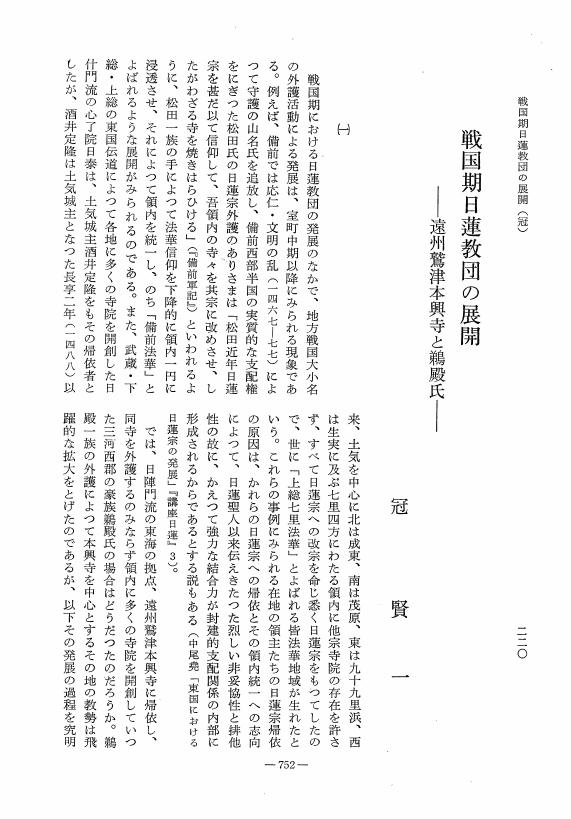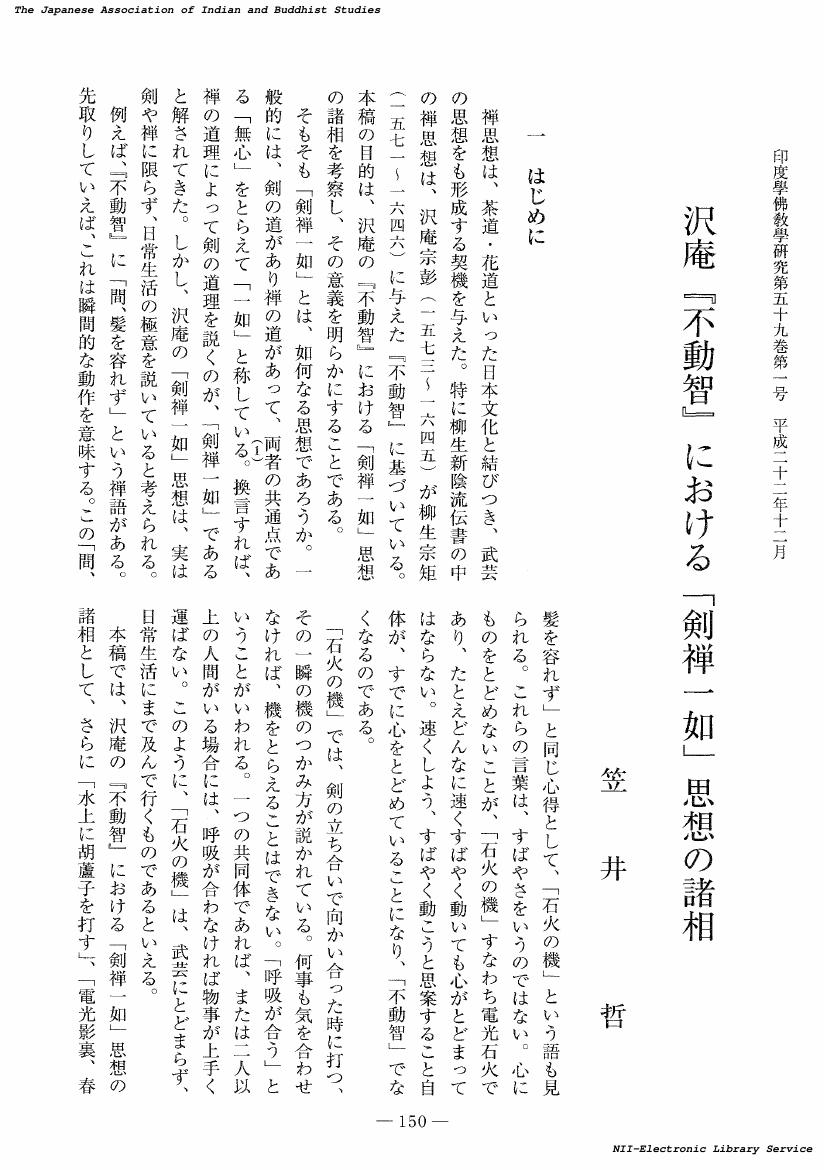1 0 0 0 OA A・バロー教授の『仏伝研究』について
- 著者
- 加藤 純章
- 出版者
- 日本印度学仏教学会
- 雑誌
- 印度學佛教學研究 (ISSN:00194344)
- 巻号頁・発行日
- vol.21, no.1, pp.397-406, 1972-12-31 (Released:2010-03-09)
1 0 0 0 OA 『楞厳経』における如来蔵について
- 著者
- 張 文良
- 出版者
- 日本印度学仏教学会
- 雑誌
- 印度學佛教學研究 (ISSN:00194344)
- 巻号頁・発行日
- vol.68, no.2, pp.734-739, 2020-03-20 (Released:2020-09-10)
- 参考文献数
- 1
According to the Śrīmālādevī-siṃhanāda Sūtra, the birth and death of all living creatures and the cause of every conditioned existence (生滅法) is not the Tathāgatagarbha, but avidyāvāsabhūmi (entrenchment of ignorance 无明住地). However, the question “Why would the Tathāgatagarbha, which is originally free from evil and defilement, generate mountains, rivers and lands (如来藏本来清净, 為什麼突然生出山河大地)?” is asked in the Śūraṅgama Sūtra, which indicates that the sūtra has a tendency to consider the Tathāgatagarbha as the origin of mountains, rivers and lands. Additionally, in the same sūtra, the Tathāgatagarbha as cittaprakṛti (心性) is qualified with the function of knowing (知). Compared to the theories of Tathāgatagarbha in Indian Buddhism, the theory in the Śūraṅgama Sūtra is apparently of a different nature. Then how did this theory form? Combining the theories of Tathāgatagarbha which were presented by Huiyuan of the Jingying-si and Fazang, this article evaluates the theory of the Tathāgatagarbha in the Śūraṅgama Sūtra on the basis of how these theories of the Tathāgatagarbha were altered.
1 0 0 0 OA 「四縁」についての一考察
- 著者
- 兵藤 一夫
- 出版者
- Japanese Association of Indian and Buddhist Studies
- 雑誌
- 印度學佛教學研究 (ISSN:00194344)
- 巻号頁・発行日
- vol.31, no.2, pp.773-776, 1983-03-25 (Released:2010-03-09)
1 0 0 0 OA 葬送儀式とアグニチャヤナ祭式
- 著者
- 井狩 弥介
- 出版者
- Japanese Association of Indian and Buddhist Studies
- 雑誌
- 印度學佛教學研究 (ISSN:00194344)
- 巻号頁・発行日
- vol.26, no.2, pp.960-954, 1978-03-20 (Released:2010-03-09)
1 0 0 0 OA 戦国期日蓮教団の展開 -遠州鷲津本興寺と鵜殿氏-
- 著者
- 冠 賢一
- 出版者
- Japanese Association of Indian and Buddhist Studies
- 雑誌
- 印度學佛教學研究 (ISSN:00194344)
- 巻号頁・発行日
- vol.22, no.2, pp.752-760, 1974-03-31 (Released:2010-03-09)
1 0 0 0 OA 近世前期の禅宗と『三賢一致書』
- 著者
- 広瀬 良文
- 出版者
- 日本印度学仏教学会
- 雑誌
- 印度學佛教學研究 (ISSN:00194344)
- 巻号頁・発行日
- vol.61, no.2, pp.556-559, 2013-03-20 (Released:2017-09-01)
1 0 0 0 破地獄偈の信仰化について
- 著者
- 盧 在性
- 出版者
- 日本印度学仏教学会
- 雑誌
- 印度學佛教學研究 (ISSN:00194344)
- 巻号頁・発行日
- vol.41, no.2, pp.617-619, 1993
1 0 0 0 奉請三宝の由来:――智顗以前に中国で行われた懺悔法を中心に――
- 著者
- 阿 純章
- 出版者
- 日本印度学仏教学会
- 雑誌
- 印度學佛教學研究 (ISSN:00194344)
- 巻号頁・発行日
- vol.56, no.1, pp.191-196, 2007
1 0 0 0 中國佛教儀禮における懺悔の受容過程
- 著者
- 鹽入 良道
- 出版者
- 日本印度学仏教学会
- 雑誌
- 印度學佛教學研究 (ISSN:00194344)
- 巻号頁・発行日
- vol.11, no.2, pp.731-736, 1963
1 0 0 0 OA 三啓集(Tridaṇḍamālā)における勝義空経とブッダチャリタ
- 著者
- 松田 和信
- 出版者
- 日本印度学仏教学会
- 雑誌
- 印度學佛教學研究 (ISSN:00194344)
- 巻号頁・発行日
- vol.68, no.1, pp.1-11, 2019-12-20 (Released:2020-09-10)
- 被引用文献数
- 3
The “Tridaṇḍa” is a ritual sūtra or sūtra used for the purpose of liturgical chanting, in which āgama-sūtras are sandwiched between Aśvaghoṣa’s verses. Researchers have so far believed that only the Anityatā-sūtra, which Yijing translated into Chinese, is the Tridaṇḍa. The Sanskrit manuscript of the Tridaṇḍamālā preserved at sPos khang monastery in Tibet, however, contains forty Tridaṇḍa sūtras. With the discovery of this manuscript, it has been proven that the Tridaṇḍa does not indicate the Anityatā-sūtra only, but rather the entire forty texts as a whole. The Anityatā-sūtra is the eleventh among those forty Tridaṇḍa texts. In this presentation, I analyze the eighth Tridaṇḍa, the Paramārthaśūnyatā-sūtra, and provide the entire Sanskrit text of the Paramārthaśūnyatā-sūtra, a famous sūtra often quoted in numerous Abhidharma treatises, fully retrieved from this manuscript for the first time. Furthermore, I was able to identify that the verses presented before and after this sūtra are from Aśvaghoṣa’s Buddhacarita. It is especially noteworthy that I was able to retrieve fifteen verses on non-self (anātman) from Canto 16 of the Buddhacarita, the Sanskrit version of which had been missing until now. Finally, I have thus far collected 123 verses, corresponding to the missing verses from the Buddhacarita Canto 15 or later from this Tridaṇḍamālā manuscript.
1 0 0 0 パーシュパタ派に受容されたシャタルドリーヤ祭詞をめぐつて
- 著者
- 木村 俊彦
- 出版者
- 日本印度学仏教学会
- 雑誌
- 印度學佛教學研究 (ISSN:00194344)
- 巻号頁・発行日
- vol.23, no.1, pp.414-418, 1974
1 0 0 0 OA 『倶舎論』における manas の語義解釈
- 著者
- 岩崎 良行
- 出版者
- Japanese Association of Indian and Buddhist Studies
- 雑誌
- 印度學佛教學研究 (ISSN:00194344)
- 巻号頁・発行日
- vol.52, no.1, pp.347-343, 2003-12-20 (Released:2010-03-09)
1 0 0 0 OA 経蔵のekaṃ samayaṃと律蔵のtena samayena
- 著者
- 森 章司
- 出版者
- 日本印度学仏教学会
- 雑誌
- 印度學佛教學研究 (ISSN:00194344)
- 巻号頁・発行日
- vol.67, no.2, pp.521-529, 2019-03-20 (Released:2019-09-20)
The Suttapiṭaka and the Vinayapiṭaka record the historical achievements of Śākyamuni. Nevertheless, “who” did “what” to “whom” “where” were written in detail, but “when” was not specified. Why so?Also, when this “when” is dated as ekaṃ samayaṃ (a certain time) in the Suttapiṭaka, the Vinayapiṭaka distinguishes it by expressing it as tena samayena (then). Why so?Śākyamuni had a consciousness that he became Buddha as result of following the ancient road that was travelled by the various Buddhas of the past, attaining enlightenment that the various Buddhas had attained, and of preaching the teachings that the various Buddhas of the past had preached. Based on this awareness were the suttas preached. Therefore, the contents of the Suttapiṭaka are universal, and it is not good to be caught in time.Meanwhile, Śākyamuni had the recognition that the dhamma was extinct because the Buddhas of the past did not preach the Pātimokkha. Under this awareness, he established the Vinayapiṭaka, legislative documents that he originally established for maintaining and developing his saṅgha. Time is an extremely important factor for the law, because the same act becomes a crime or not depending on when the law was enacted.The Suttapiṭaka and the Vinayapiṭaka are canonical records. The Buddha’s disciples edited the suttas in a form not limiting time using ‘ekaṃ samayaṃ,’ and edited the rules in a way that limits “time” using ‘tena samayena’. This is a poor measure of trying to solve two conflicting requests at the same time. Tena samayena does not mean “when”. Therefore, there were no biographies of Buddha in Buddhism.
1 0 0 0 IR 清沢満之の進化論批判
- 著者
- 角田 玲子
- 出版者
- 日本印度学仏教学会
- 雑誌
- 印度學佛教學研究 (ISSN:00194344)
- 巻号頁・発行日
- vol.53, no.2, pp.715-717, 2005
1 0 0 0 近代仏教音楽の明治・大正
- 著者
- 山口 淳有
- 出版者
- 日本印度学仏教学会
- 雑誌
- 印度學佛教學研究 (ISSN:00194344)
- 巻号頁・発行日
- vol.49, no.2, pp.582-584, 2001
1 0 0 0 ブッダからブラフマンへ--さらにその太初へ
- 著者
- 玉城 康四郎
- 出版者
- 日本印度学仏教学会
- 雑誌
- 印度學佛教學研究 (ISSN:00194344)
- 巻号頁・発行日
- vol.46, no.1, pp.151-158, 1997-12
1 0 0 0 OA 沢庵『不動智』における「剣禅一如」思想の諸相
- 著者
- 笠井 哲
- 出版者
- 日本印度学仏教学会
- 雑誌
- 印度學佛教學研究 (ISSN:00194344)
- 巻号頁・発行日
- vol.59, no.1, pp.150-156, 2010-12-20 (Released:2017-09-01)
1 0 0 0 OA ティラウラコットにおける近年の考古学調査について
- 著者
- 村上 東俊
- 出版者
- 日本印度学仏教学会
- 雑誌
- 印度學佛教學研究 (ISSN:00194344)
- 巻号頁・発行日
- vol.65, no.1, pp.288-283, 2016-12-20 (Released:2017-10-17)
- 参考文献数
- 14
The UNESCO/JFIT project, “Strengthening the Conservation and Management of Lumbini, the Birthplace of the Lord Buddha, Phase 2,” focused on investigation of Tilaurakot, has been ongoing since 2014. An International excavation team of experts is co-directed by Professor Robin Coningham of Durham University and Former Director General Kosh Prasad Acharya of the Department of Archaeology, and the project is comprised of members from Durham University, the Lumbini Development Trust, the Department of Archaeology, the National Geographic, and others. The project is focusing on the morphological and chronological definition of Tilaurakot.The purpose of this paper is to report the archaeological results form Lumbini (2010–2013) and describe in outline the current archaeological survey of Tilaurakot (2014–2017).
1 0 0 0 『立正安国論』の自界叛逆難について
- 著者
- 佐藤 祐規
- 出版者
- 日本印度学仏教学会
- 雑誌
- 印度學佛教學研究 (ISSN:00194344)
- 巻号頁・発行日
- vol.48, no.2, pp.829-831, 2000
1 0 0 0 アンベードカールの佛教觀
- 著者
- 藤吉 慈海
- 出版者
- 日本印度学仏教学会
- 雑誌
- 印度學佛教學研究 (ISSN:00194344)
- 巻号頁・発行日
- vol.12, no.2, pp.612-615, 1964






